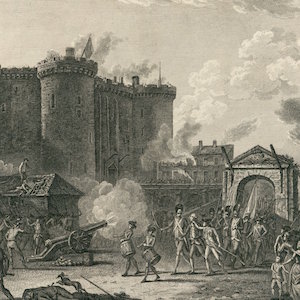Europe

Taking of the Bastille
The "bravery of the citizens united against" the royal army, as the text suggests, enabled them to conquer in four hours a fortress that had defeated invasions since 1368.

Taking of the Bastille
This painting emphasizes the populace’s participation in the storming of the Bastille, showing the urban population fighting under a red banner with muskets, swords, and pikes against the royal soldiers.

The Third Incident of 14 July 1789
This engraving from the Berthault series depicts Stanislas Maillard bravely climbing on a plank over the dry moat surrounding the fortress to accept from one of the soldiers Launay’s "capitulation" of the Bastille.

Photograph of Fatima the Moroccan
By 1900, only the Kingdom of Morocco remained more or less independent of European rule, although European competition for Morocco was intense between Spain, France, and Germany. Between 1899 and 1912, French armies progressively occupied the country using Algeria as a base.

Beautiful Fatima
Photography was critical to imperialism. The French army (and the British army in India) employed the camera’s lens to chronicle military exploits, first in Algeria during the 1850s, and later in Tunisia and Morocco.

In Memoriam
In 1857, British rule in India was challenged when Indian sepoy troops of the British Indian Army began a year-long insurrection against the British. To the British, the most shocking aspect of the events in India was the massacre of white women and children by Indian men.

Scotland Forever
Painted by Elizabeth Butler, Scotland Forever (1881), depicts the charge of the Heavy Cavalry at the battle of Waterloo fought in 1815. The British victory at Waterloo ended the Napoleonic Wars, and ensured Britain’s position as the worlds most dominant imperial power.

The Children of Edward Holden Cruttenden
This 18th-century painting of the children of Edward Cruttenden depicted with their ayah was painted in Britain by Joshua Reynolds. The earliest immigrants from India came to Britain as the servants of employees of the East India Company.

Susanna and the Elders
Susanna and the Elders, a 17th-century Italian painting by Artemisia Gentileschi, portrays the biblical story of Susanna, a virtuous Jewish woman preyed upon by two judges, important members of the community. Without her knowing, the men spied on her while she bathed.

Analyzing Census Data
The modules in Methods present case studies that demonstrate how scholars interpret different kinds of historical evidence in world history. In the video below, historian Mills Kelly discusses the data from the 1910 census of the Hapsburg Monarchy.